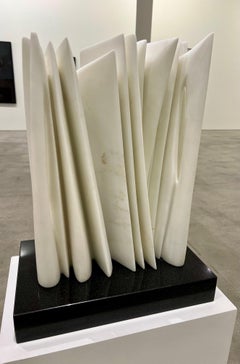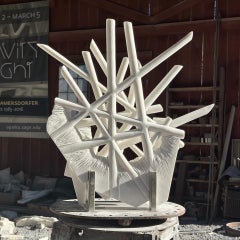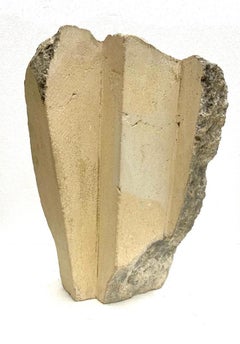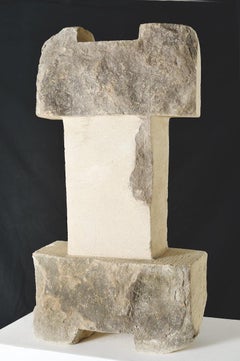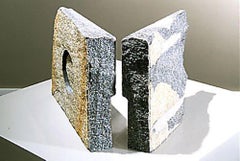Stone Sculptures
to
42
126
72
49
45
89
Overall Width
to
Overall Height
to
53
328
4
7
7
16
903
381
104
49
37
21
20
6
5
4
3
3
1
5
4
4
3
3
3
3
3
3
3
2
2
2
2
2
2
2
1
1
1
80,282
1,865
822
619
519
76
17
16
12
7
180
159
Style: Abstract
Medium: Stone
Untitled
Located in Miami, FL
Las obras del maestro Atchugarry vienen de la naturaleza, es una piedra de marmol forjada por siglos, unica he irrepetible, luego son esculpidas a mano usando las tecnicas originales...
Category
2010s Abstract Geometric Stone Sculptures
Materials
Marble
Price Upon Request
Untitled
Located in Miami, FL
Las obras del maestro Atchugarry vienen de la naturaleza, es una piedra de marmol forjada por siglos, unica he irrepetible, luego son esculpidas a mano usando las tecnicas originales...
Category
2010s Abstract Geometric Stone Sculptures
Materials
Marble
Price Upon Request
"Inner View Open_Nexus III" Abstract Marble Sculpture by Caroline Ramersdorfer
Located in New York, NY
"Inner View Open_ Nexus III" by Caroline Ramersdorfer
Three layered, marble slabs on a steel pedestal
(each slab is 1.5" thick")
Ramersdorfer carves slabs of marble to reveal comple...
Category
2010s Abstract Stone Sculptures
Materials
Stone, Marble, Steel, Metal, Stainless Steel
Volumen VPC-038
Located in Miami, FL
Volumen
VPC-038, 1970
Unique Piece
Direct carving on Cumarebo stone
40 x 32 x 20 cm
15.7 x 12.5 x 7.8 in
ABOUT THE ARTIST
Narváez was born in Porlamar, Venezuela, in 1905; he was the fifth son of eleven siblings; his parents were Jose Lorenzo Narváez and Vicenta Rivera. Don José Lorenzo, a multifaceted and creative man, sowed the seed of creativity in his son. “My father did not fit in with his fantasies of cabinetmaker, bricklayer, master builder, and self-taught architect.”1 From an early age, Francis was led to the artistic activity, he traced, carved, made replicas of the furniture and the saints restored by his father.
In 1920 he obtained his first professional assignment, a San Rafael for the Church of Carupano, and, in 1922, his father authorized him to travel to Caracas to pursue his studies as an artist. He studied at the atelier of Marcos Castillo, at of the Angel Cabre y Magriña and at the Academy of Fine Arts in Caracas, where he was introduced to the painters and intellectuals of the time.
In 1928 he presented his first solo exhibition at the Club Venezuela. With the money raised from the sale of the works and the support of Monsignor Sosa, and the Ministers Centeno Grau and Arcaya, he studied in Paris on a scholarship. Once there, he enrolled at the Académie Julian, where Tito Salas, Cristóbal Rojas and Arturo Michelena had also studied. It was in Paris where, unable to work in wood, he turned to stone carving. “In Paris, I didn’t have wood, so I carved a lot in stone (…), when there were demolitions I purchased chunks of stone, I would take them to the workshop and carve them.”2
His first attempts at volumetric sculptures and painting in plain colours, linked to the thematic of American miscegenation and Creole reality, can be traced back to that first trip to Paris. During his stay in the French city, Arturo Uslar Pietri, Alfredo Boulton, and Finita Vallenilla supported the artist both financially and logistically, and in February of 1930, the trio of friends arranged another exhibition for him at the Club Venezuela. Narváez describes his exhibition as follows: “(…) in it I feel that the sculptural work is more my own, done with more assurance, a response to my pursuit of large planes, stylisation and synthesis.”3 By then, as Boulton himself noted in his book about the artist, Narvaez departed from most of the artistic traditions that prevailed by that time in Venezuela.
In 1931 he returned to Caracas and established his atelier at the Barrio Obrero in Catia. The atelier became the hub of the intellectual life of the time. “In those years, the atelier of Francisco Narváez was the hub of the greatest Venezuelan hope. Nothing comparable to it can be found either before or since.”4
From that year onwards, exhibitions, projects, trips, and awards we multiplied. He was awarded the President of the Republic of Venezuela Prize, the National Sculpture Prize of the 1st Official Venezuelan Art Salon, and the John Boulton Prize of the 3rd Annual Venezuelan Art Salon; for the Military Academy, he produced a spectacular relief entitled La Patria.
In 1945, commissioned by the architect Carlos Raúl Villanueva, he produced two groups of sculptures known as Las Toninas, both located in the O’Leary Square. There, as he himself states, he incorporates some baroque patterns into the figures to the source itself: “It is a work of balance between the decorative requirements and the sculpture of planes and angles.”5
In 1948 he was awarded the National Painting Prize. In the same year, he was called upon by the architect Carlos Raul Villanueva to participate in the project for the arts integration in the Universidad Central de Venezuela. Francisco Narváez’s public output continued with works such as the statue of Fermín Toro, La Educación, La Ciencia, three murals (produced by María Luisa Tovar) for the Instituto de Medicina Experimental, El Cristo; el Atleta, the equestrian statue of General Rafael Urdaneta.
In 1953 he was appointed Director of the School of Plastic and Applied Arts, and in July of the same year, he exhibited “Francisco Narváez, Maderas, Piedras y Bronces” (Francisco Narváez, Woods, Stones and Bronzes) at the Museum of Fine Arts.
Narváez is, unquestionably, one of the great Venezuelan sculptors, his work goes through various stages and interests; as the art world evolves, the artist does not remain in his initial scopes of work. His creations are not imposed by the prevailing trends or fashion but do evolve by experimenting with new materials and interests.
When one peruses the artist’s lengthy list of exhibitions, commissions, and awards, it is worth remembering the Narvaez who embark on his career as a child and who, overcoming obstacles, knew how to make the most of his curiosity. He did not settle for living off his successes. He did not remain stagnant as many creators of his environment did. Narvaez managed to understand the changes in the history of art around him. We must not overlook the fact that Francisco Narvaez is an artist amid all the changes occurring in the art world. He moves from the classics to the great transformations in the art world. It is the Europe of Picasso, Braque, Arp. He observes, he is aware of what is happening in the centres of the world of art, but between his craft and his sensitivity, the result is NARVAEZ, his stamp, and his identity.
Francisco Narváez comes from tradition, and his first stage is linked to the classics, to the exploration of his heritage, but always with his very own language. Throughout his prolific career, he knew how to remain true to himself, without disregarding the influences of his surroundings or his artistic interests: his ability as a sculptor, his selection of materials, whether they were wood, stone or bronze; his choice of the subject of his work…His mastery and great craftsmanship are a constant that over time have made him a leading player in the history of contemporary Venezuelan and world art.
From his beginnings, no subject was foreign to him. His paintings, drawings, aquarelles, and sketches are testimony to his prolific output. Among his themes are portraits, our traditions, still lifes, and landscapes. Narváez is an artist who represents his time. Later, he evolved towards purer and simpler forms, abandoning figurative art for short periods.
In 1956 he declared to the newspaper El Nacional: “Every day I am freeing myself, it is a soul that frees itself from the ephemeral wrappings of the circumstantial always, as well as from the inevitable weight of the anecdote. This second stage of my work is remarkably close to abstractionism, even if there are still certain figures or figurations in the sculptures that I will shortly be showing. However, pure, and absolute abstractionism, it will treat the form itself as the sole reason for its existence on the plane of artistic excellence.”6
The artistic development was his professional life. Each period of his life as an artist, he went one step further, searching, solving, seeing plenty of things and understanding how diverse expressions were transforming themselves. His hands followed his gaze and his mind, always inquisitive. He added movement to the volumes.
Arturo Uslar Pietri, “Formas Nuevas”, Cromotip editions, 1956 “Francisco Narváez is a path: the path that Venezuelan sculpture...
Category
1970s Abstract Stone Sculptures
Materials
Stone
Price Upon Request
Volumen VPC-062
Located in Miami, FL
Volumen
VPC-062, 1972
Unique Piece
Direct carving on Cumarebo stone
67 x 38 x 20 cm
26.3 x 14.9 x 7.8 in.
ABOUT THE ARTIST
Narváez was born in Porlamar, Venezuela, in 1905; he was the fifth son of eleven siblings; his parents were Jose Lorenzo Narváez and Vicenta Rivera. Don José Lorenzo, a multifaceted and creative man, sowed the seed of creativity in his son. “My father did not fit in with his fantasies of cabinetmaker, bricklayer, master builder, and self-taught architect.”1 From an early age, Francis was led to the artistic activity, he traced, carved, made replicas of the furniture and the saints restored by his father.
In 1920 he obtained his first professional assignment, a San Rafael for the Church of Carupano, and, in 1922, his father authorized him to travel to Caracas to pursue his studies as an artist. He studied at the atelier of Marcos Castillo, at of the Angel Cabre y Magriña and at the Academy of Fine Arts in Caracas, where he was introduced to the painters and intellectuals of the time.
In 1928 he presented his first solo exhibition at the Club Venezuela. With the money raised from the sale of the works and the support of Monsignor Sosa, and the Ministers Centeno Grau and Arcaya, he studied in Paris on a scholarship. Once there, he enrolled at the Académie Julian, where Tito Salas, Cristóbal Rojas and Arturo Michelena had also studied. It was in Paris where, unable to work in wood, he turned to stone carving. “In Paris, I didn’t have wood, so I carved a lot in stone (…), when there were demolitions I purchased chunks of stone, I would take them to the workshop and carve them.”2
His first attempts at volumetric sculptures and painting in plain colours, linked to the thematic of American miscegenation and Creole reality, can be traced back to that first trip to Paris. During his stay in the French city, Arturo Uslar Pietri, Alfredo Boulton, and Finita Vallenilla supported the artist both financially and logistically, and in February of 1930, the trio of friends arranged another exhibition for him at the Club Venezuela. Narváez describes his exhibition as follows: “(…) in it I feel that the sculptural work is more my own, done with more assurance, a response to my pursuit of large planes, stylisation and synthesis.”3 By then, as Boulton himself noted in his book about the artist, Narvaez departed from most of the artistic traditions that prevailed by that time in Venezuela.
In 1931 he returned to Caracas and established his atelier at the Barrio Obrero in Catia. The atelier became the hub of the intellectual life of the time. “In those years, the atelier of Francisco Narváez was the hub of the greatest Venezuelan hope. Nothing comparable to it can be found either before or since.”4
From that year onwards, exhibitions, projects, trips, and awards we multiplied. He was awarded the President of the Republic of Venezuela Prize, the National Sculpture Prize of the 1st Official Venezuelan Art Salon, and the John Boulton Prize of the 3rd Annual Venezuelan Art Salon; for the Military Academy, he produced a spectacular relief entitled La Patria.
In 1945, commissioned by the architect Carlos Raúl Villanueva, he produced two groups of sculptures known as Las Toninas, both located in the O’Leary Square. There, as he himself states, he incorporates some baroque patterns into the figures to the source itself: “It is a work of balance between the decorative requirements and the sculpture of planes and angles.”5
In 1948 he was awarded the National Painting Prize. In the same year, he was called upon by the architect Carlos Raul Villanueva to participate in the project for the arts integration in the Universidad Central de Venezuela. Francisco Narváez’s public output continued with works such as the statue of Fermín Toro, La Educación, La Ciencia, three murals (produced by María Luisa Tovar) for the Instituto de Medicina Experimental, El Cristo; el Atleta, the equestrian statue of General Rafael Urdaneta.
In 1953 he was appointed Director of the School of Plastic and Applied Arts, and in July of the same year, he exhibited “Francisco Narváez, Maderas, Piedras y Bronces” (Francisco Narváez, Woods, Stones and Bronzes) at the Museum of Fine Arts.
Narváez is, unquestionably, one of the great Venezuelan sculptors, his work goes through various stages and interests; as the art world evolves, the artist does not remain in his initial scopes of work. His creations are not imposed by the prevailing trends or fashion but do evolve by experimenting with new materials and interests.
When one peruses the artist’s lengthy list of exhibitions, commissions, and awards, it is worth remembering the Narvaez who embark on his career as a child and who, overcoming obstacles, knew how to make the most of his curiosity. He did not settle for living off his successes. He did not remain stagnant as many creators of his environment did. Narvaez managed to understand the changes in the history of art around him. We must not overlook the fact that Francisco Narvaez is an artist amid all the changes occurring in the art world. He moves from the classics to the great transformations in the art world. It is the Europe of Picasso, Braque, Arp. He observes, he is aware of what is happening in the centres of the world of art, but between his craft and his sensitivity, the result is NARVAEZ, his stamp, and his identity.
Francisco Narváez comes from tradition, and his first stage is linked to the classics, to the exploration of his heritage, but always with his very own language. Throughout his prolific career, he knew how to remain true to himself, without disregarding the influences of his surroundings or his artistic interests: his ability as a sculptor, his selection of materials, whether they were wood, stone or bronze; his choice of the subject of his work…His mastery and great craftsmanship are a constant that over time have made him a leading player in the history of contemporary Venezuelan and world art.
From his beginnings, no subject was foreign to him. His paintings, drawings, aquarelles, and sketches are testimony to his prolific output. Among his themes are portraits, our traditions, still lifes, and landscapes. Narváez is an artist who represents his time. Later, he evolved towards purer and simpler forms, abandoning figurative art for short periods.
In 1956 he declared to the newspaper El Nacional: “Every day I am freeing myself, it is a soul that frees itself from the ephemeral wrappings of the circumstantial always, as well as from the inevitable weight of the anecdote. This second stage of my work is remarkably close to abstractionism, even if there are still certain figures or figurations in the sculptures that I will shortly be showing. However, pure, and absolute abstractionism, it will treat the form itself as the sole reason for its existence on the plane of artistic excellence.”6
The artistic development was his professional life. Each period of his life as an artist, he went one step further, searching, solving, seeing plenty of things and understanding how diverse expressions were transforming themselves. His hands followed his gaze and his mind, always inquisitive. He added movement to the volumes.
Arturo Uslar Pietri, “Formas Nuevas”, Cromotip editions, 1956 “Francisco Narváez is a path: the path that Venezuelan sculpture...
Category
1970s Abstract Stone Sculptures
Materials
Stone
Price Upon Request
Maquette No. 1
Located in New York, NY
Lika Mutal is a Dutch-Peruvian sculptor, who worked on diverse stones and material from Peru, inspired on Pre-Columbian art.
Category
1980s Abstract Stone Sculptures
Materials
Granite
Price Upon Request
Red Tree on a Stand
Located in New York, NY
A sculpture made with glass layers and painted with nail polish and acrylic, set on a cement pedestal.
The glass leaves are separated by slits on the pedestal, giving the sculpture ...
Category
2010s Abstract Stone Sculptures
Materials
Limestone
Price Upon Request
"Ascension (red reamer)", Abstract Outdoor Sculpture, Stone, Metal, Industrial
Located in New York, NY
"Ascension (red reamer)" by John Van Alstine
Granite, red pigmented and sealed steel
The sculpture of John Van Alstine beautifully, and powerfully, balances the union of stone and m...
Category
21st Century and Contemporary Abstract Stone Sculptures
Materials
Stone, Granite, Metal, Steel
Wire with Golden Arms (2020), abstract sculpture, concrete, wire, copper, gold
Located in Jersey City, NJ
Biomorphic and earthy yet industrial style wall or tabletop sculpture. Abstract wire form with corrugated concrete form. The piece is smooth and rough, with gold pigmented concrete...
Category
2010s Abstract Stone Sculptures
Materials
Concrete, Wire, Copper
Dancing Wire Form (2022), terracotta concrete abstract sculpture, metal wire
Located in Jersey City, NJ
Biomorphic and earthy yet industrial style wall or tabletop sculpture. Abstract wire form with corrugated hydrocal plaster form. The piece is smooth and...
Category
2010s Abstract Stone Sculptures
Materials
Concrete, Wire
"INNER VIEW VII" Organic, Abstract Marble Sculpture by Caroline Ramersdorfer
Located in New York, NY
"INNER VIEW VII" by Caroline Ramersdorfer
Seven layered, marble slabs on a steel pedestal
(each slab measures 12" x 12" x .75")
Ramersdorfer carves slabs of marble to reveal complex...
Category
21st Century and Contemporary Abstract Stone Sculptures
Materials
Stone, Marble, Steel
Pedro Barreto, Esfera, Marble, ø 25.6 in. ø 65 cm
Located in Miami, FL
Pedro Barreto
Esfera, Undated
Marble
ø 25.6 in. ø 65 cm (Depth 5.9 in. 15 cm)
Base: 7.9 x 7.9 x 9.8 in. 20 x 20 x 25 cm
Pedro Barreto (b. Santa Catalina, Venezuela, 1935; d. Lechería, Venezuela, 2008)
His first experiences as a sculptor were with wood, influenced by his place of birth in the Orinoco River delta.
Between 1954 and 1958, he studies at the Plastic and Applied Arts School of Caracas.
In 1957, his first one-man exhibition took place in Tucupita, earning him a scholarship to study in Europe.
He attends the School of Fine Arts of Rome until 1960, after which he travels to Paris and works in Agustín Cárdenas’ studio.
In 1973, he is awarded Tokyo’s Shinsakasho Prize and Venezuela’s Salón Arturo Michelena.
Category
Late 20th Century Abstract Stone Sculptures
Materials
Marble
Price Upon Request
"Black Tower" Large-Scale, Abstract Metal Sculpture in bronze
By Joel Perlman
Located in New York, NY
"Black Tower" by Joel Perlman
Unique cast bronze, marble base
Joel Perlman has been creating complex sculptures out of steel, bronze, and aluminum since the early 1970's. While minimalism was the predominant style of his genration, Perlman chose to push his forms into ever-more complicated, gravity defying, configurations. Perlman investigates with originality. He expands, rather than appropriates, enriching our experience with industrial materials.
Contemporary, Abstract Outdoor Metal...
Category
2010s Abstract Stone Sculptures
Materials
Marble, Metal, Bronze
"INNER VIEW_Nexus_cellular", Organic, Abstract Marble Sculpture, Large Outdoor
Located in New York, NY
"INNER VIEW_Nexus_cellular" by Caroline Ramersdorfer
Marble and stainless steel
Shippable in 8-10 weeks. Please contact gallery for further information.
Ramersdorfer carves slabs o...
Category
21st Century and Contemporary Abstract Stone Sculptures
Materials
Marble, Stainless Steel
"INNER VIEW_Open_Nexus II" Organic, Abstract Marble Sculpture
Located in New York, NY
"INNER VIEW_Open_Nexus II" by Caroline Ramersdorfer
Marble and stainless steel
Shippable in 8-10 weeks. Please contact gallery for further information.
Ramersdorfer carves slabs of...
Category
21st Century and Contemporary Abstract Stone Sculptures
Materials
Marble, Stainless Steel
"INNER VIEW_Wings towards Reflection" Abstract Marble Sculpture, Large Outdoor
Located in New York, NY
"INNER VIEW_Wings towards Reflection" by Caroline Ramersdorfer
Marble and stainless steel
Shippable in 8-10 weeks. Please contact gallery for further information.
Ramersdorfer carv...
Category
21st Century and Contemporary Abstract Stone Sculptures
Materials
Marble, Stainless Steel
"Three Strikes" Abstract, Cast Stainless Steel Metal Sculpture by John Ruppert
By John Ruppert
Located in New York, NY
"Three Strikes" by John Ruppert
Rock, cast stainless steel from fragments of trees struck by lightning
Over the past 35 years, John Ruppert has been working in cast metals; manufact...
Category
2010s Abstract Stone Sculptures
Materials
Stone, Metal, Steel, Stainless Steel
White Marble Abstract Sculpture by Sergio Camargo
Located in Long Island City, NY
Artist: Sergio Camargo, Brazilian (1930 - 1990)
Medium: White Marble Sculpture, signature inscribed on base front
Size: 7.875 x 12.25 x 10.25 inches ; 2...
Category
1980s Abstract Geometric Stone Sculptures
Materials
Marble
PLANET BLUES
By Matthias Contzen
Located in New Orleans, LA
This sculpture will be exhibited at Scope Art Fair Miami Beach 2017
Category
2010s Abstract Stone Sculptures
Materials
Marble
Price Upon Request
"Cumulus Stone No. 3" Large Abstract Carved Marble Sculpture, Mirror Base
Located in New York, NY
"Cumulus Stone No. 3" by Norman Mooney
Bardiglio Imperiale marble, stainless steel
In 1994 Mooney moved from Ireland to New York City and has been exhibiting locally and internation...
Category
21st Century and Contemporary Abstract Stone Sculptures
Materials
Stone, Marble, Steel, Stainless Steel, Metal
"Cumulus Stone No. 1" Large Abstract Carved Marble Sculpture, Mirror Base
Located in New York, NY
"Cumulus Stone No. 1" by Norman Mooney
Carrara Marble, Stainless Steel
In 1994 Mooney moved from Ireland to New York City and has been exhibiting locally and internationally for mor...
Category
2010s Abstract Stone Sculptures
Materials
Stone, Marble, Steel, Stainless Steel, Metal
Stone sculptures for sale on 1stDibs.
Find a wide variety of authentic Stone sculptures available on 1stDibs. While artists have worked in this medium across a range of time periods, art made with this material during the 21st Century is especially popular. If you’re looking to add sculptures created with this material to introduce a provocative pop of color and texture to an otherwise neutral space in your home, the works available on 1stDibs include elements of blue, purple, green, orange and other colors. There are many well-known artists whose body of work includes ceramic sculptures. Popular artists on 1stDibs associated with pieces like this include John Van Alstine, Ted VanCleave, Tony Moore, and Kuno Vollet. Frequently made by artists working in the Contemporary, Abstract, all of these pieces for sale are unique and many will draw the attention of guests in your home. Not every interior allows for large Stone sculptures, so small editions measuring 0.12 inches across are also available
